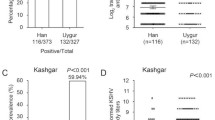Abstract
Infection with human herpes virus 8 (HHV8) is associated with development of Kaposi’s sarcoma (KS); therefore also known as KS-associated herpes virus. KS is closely associated with human immunodeficiency virus (HIV) infection, and consequently HHV8 seroprevalence is higher in HIV-infected compared to HIV-negative patients. Currently, KS is rarely seen in clinical practice, which might be a consequence of an optimized anti-HIV treatment leading to an improved immunological status, or alternatively of a decrease in HHV8 prevalence. To determine the prevalence of HHV8 antibodies in HIV-positive compared to HIV-negative patients from the University Hospital Frankfurt/Main, Germany, and to compare our results with previously published data to illustrate trends in the spread of infection. Hundred serum samples each of HIV-positive and HIV-negative patients were analyzed for HHV8 antibodies by using an IgG immunofluorescence test. The overall HHV8 seroprevalence was 16% with no statistically significant gender-specific differences; however, the distribution between the HIV-infected patients and the HIV-negative control group was significantly different (30 and 2%, respectively). The highest rate of seroprevalence in HIV-infected patients was detected at the age of 40–49 (42%) and the lowest rate at the age of 20–29 years (16.6%). In comparison with formerly conducted studies, our data clearly showed an increase in the HHV8 seroprevalence in HIV-infected patients, both in men and women. Therefore, we conclude that the low rate of clinical KS is associated with an improved immunological status due to an optimized anti-HIV therapy.


Similar content being viewed by others
References
Chang Y, Cesarman E, Pessin MS et al (1994) Identification of new herpes virus-like DNA sequences in AIDS-associated Kaposi’s sarcoma. Science 266:1865–1869
Neipel F et al (1999) Human herpesvirus 8: is it a tumor virus? Proc Assoc Am Physicians 111(6):594–601
Kaposi M (1928) Classics in oncology. Idiopathic multiple pigmented sarcoma. Cancer J Clin 32:342
Brook JJ (1986) Kaposi’s sarcoma—a reversible hyperplasia. Lancet II 1309
Centers for Disease Contol and Prevention (CDC) (1981) Kaposi’s sarcoma and Pneumocystis pneumonia among homosexual men–New York City and California. Morb Mortal Wkly Rec 30:305–308
Centers for Disease Contol and Prevention (CDC) (1982) A cluster of Kaposi’s sarcoma and Pneumocystis carinii pneumonia among homosexual male residents of Los Angeles and range counties, California. Morb Mortal Wkly Rec 18:305–307
Beral V, Peterman TA, Berkelman RL et al (1990) Kaposi’s sarcoma among persons with AIDS: a sexually transmitted infection? Lancet 335:123–128
Couturier E, Ancelle-Park RA, de Vincenzi I et al (1990) Kaposi’s sarcoma as a sexually transmitted disease. Lancet 335:1105
FJJr Palella, Delaney KM, Moorman AC et al (1998) Declining morbidity and mortality among patients with advanced human immunodeficiency virus infection. HIV outpatient study investigators. N Engl J Med 338:853–860
Seaberg EC et al (2010) Cancer incidence in the multicenter aids cohort study before and during the HAART era. Cancer 116(23):5344–5347
Mocroft A, Kirk O, Clumeck N et al (2004) The changing pattern of Kaposi’s sarcoma in patients with HIV, 1994–2003: the EuroSIDA Study. Cancer 100(12):2644–2654
Franceschi S, Maso LD, Rickenbach M et al (2008) Kaposi’s sarcoma incidence in the Swiss HIV cohort study before and after highly active antiretroviral therapy. Br J Cancer 99(5):800–804
Grossman Z et al (2002) Absence of Kaposi’s sarcoma among Ethiopian immigrants to Israel despite high seroprevalence of human herpesvirus 8. Mayo Clin Proc 77:905–909
Sullivan RJ et al (2008) Epidemiology, pathophysiology and treatment of Kaposi’s sarcomaassociated herpesvirus disease: Kaposi’s sarcoma, primary effusion lymphoma, and multicentric Castleman disease. Clin Infect Dis 47(9):1209–1215
Plancoulaine S, Abel L, van Beveren M et al (2000) Human herpesvirus 8 transmission from mother to child and between siblings in an endemic population. Lancet 356:1062–1065
Casper C, Carrell D, Miller KG et al (2006) HIV serodiscordant sex partners and the prevalence of human herpesvirus 8 infection among HIV negative men who have sex with men: baseline data from the EXPLORE study. Sex Transm Infect 82:229–235
Casper C, Wald A, Pauk J et al (2002) Correlates of prevalent and incident Kaposi’s sarcomaassociated herpesvirus infection in men who have sex with men. J Infect Dis 185:990–993
Cannon MJ, Dollard SC, Smith DK et al (2001) Blood-borne and sexual transmission of human herpesvirus 8 in women with or at risk for human immunodeficiency virus infection. N Engl J Med 344:637–643
Hladik W, Dollard SC, Mermin J et al (2006) Transmission of human herpesvirus 8 by blood transfusion. N Engl J Med 355:1331–1338
Luppi M, Barozzi P, Santagostino G et al (2000) Molecular evidence of organ-related transmission of Kaposi’s sarcoma-associated herpesvirus or human herpesvirus-8 in transplant patients. Blood 96:3279–3281
Barozzi P, Luppi M, Facchetti F et al (2003) Post-transplant Kaposi’s sarcoma originates from the seeding of donor-derived progenitors. Nat Med 9:554–561
Preiser W, Szép NI, Lang D, Doerr HW (2001) Rabenau HF: Kaposi’s sarcoma-associated herpesvirus seroprevalence in selected German patients: evaluation by different test systems. Med Microbiol Immunol 190:121–127
Sullivan RJ et al (2009) Targeted therapy in Kaposi sarcoma. BioDrugs 23(2):69–75
Stuermer M, Doerr HW, Guertler L (2009) Human immunodeficiency virus: 25 years of diagnostic and therapeutic strategies and their impact on hepatitis B and C virus. Med Microbiol Immunol 198:147–155
Qu L, Jenkins F, Triulzi DJ (2010) Human herpesvirus 8 genomes and seroprevalence in United States blood donors. Transfusion 50(5):1050–1056
Mei Q, Ming ZW, Ping YX et al (2007) HHV-8 seroprevalence in blood donors and HIV-positive individuals in Shandong area. China. J Infect 55(1):89–90
McDonald AC, Ragin CC, Jenkins FJ et al (2009) Human herpesvirus 8 seroprevalence among Tobago women and the role of sexual lifestyle behavior. J Med Virol 81(2):264–270
Robert Koch-Institut, Epidemiologische Bulletin Nr. 22/2010 205–20
Author information
Authors and Affiliations
Corresponding author
Rights and permissions
About this article
Cite this article
Reinheimer, C., Allwinn, R. & Stürmer, M. Do fewer cases of Kaposi’s sarcoma in HIV-infected patients reflect a decrease in HHV8 seroprevalence?. Med Microbiol Immunol 200, 161–164 (2011). https://doi.org/10.1007/s00430-011-0187-0
Received:
Published:
Issue Date:
DOI: https://doi.org/10.1007/s00430-011-0187-0




